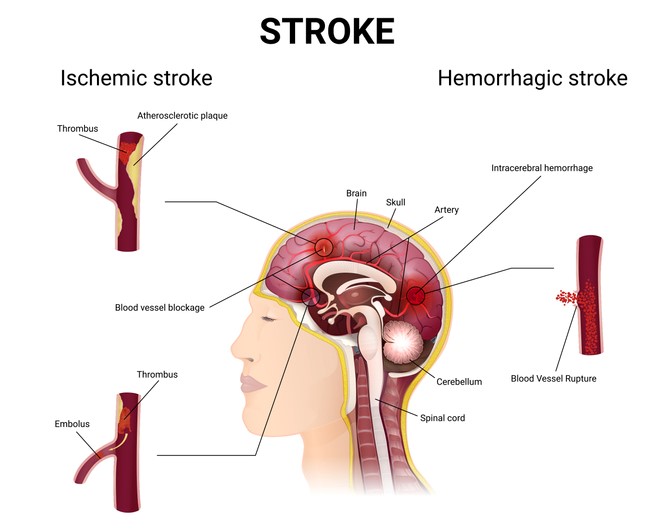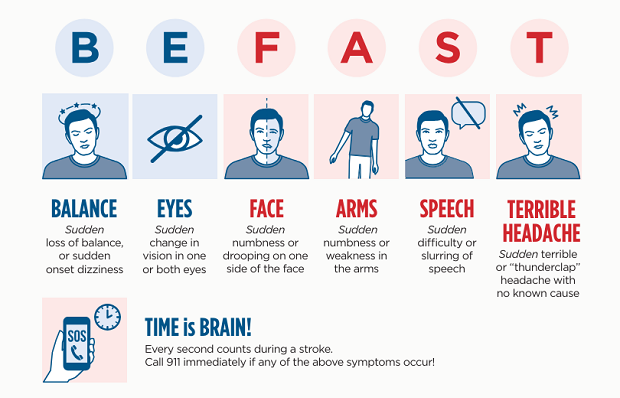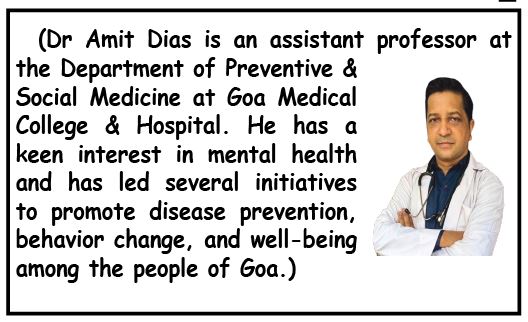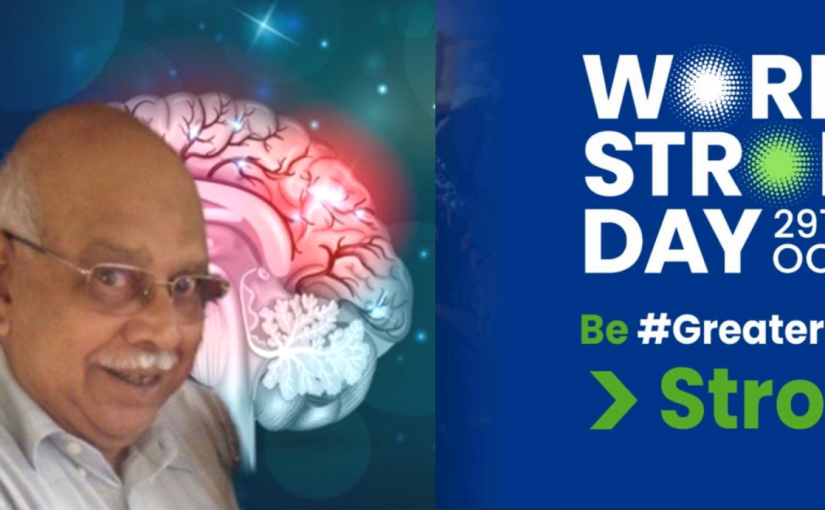World Stroke Day!
World Stroke Day is observed on October 29. On this occasion we spoke to Dr Amit Dias who shared insights on stroke awareness, prevention and management. He says, “The theme this year is Be Greater than Stroke. It encourages us to stay informed and proactive in preventing strokes.” This interview on stroke awareness is dedicated to Dr Chicot Vas, Goa’s eminent neurologist, for his contribution to neurology and stroke management in the state of Goa.
An interview with Dr Amit Dias on World Stroke Day
Goan Observer: Doctor, we appreciate the fact that you want to dedicate this stroke awareness interview to Dr Chicot Vas…could you throw more light on it?
Dr Amit Dias: October 29, celebrated globally as World Stroke Day, coincides with the birthday of Dr Chicot Vas, who established the Department of Neurology at the Goa Medical College and founded the Dementia Society of Goa. He has made significant contributions to stroke, epilepsy, dementia treatment in Goa. He should rightfully be called the “Father of Neurology” in Goa. This year, on his 90th birthday, I want to honor him by dedicating this effort to raise stroke awareness as a tribute to his legacy. He has been an exceptional mentor and an inspiring influence in my life and that of many others, and everything we know today reflects his teachings and guidance. I wish him a very happy birthday and extend my heartfelt gratitude for all he has done.
Q: We wish Dr Vas a very happy birthday as well, do share insights into his teaching. Could you start by explaining what a stroke is?
A: Our brain receives nutrients through a network of blood vessels. A stroke, or cerebrovascular accident, is a medical emergency that occurs when blood flow to a part of the brain is interrupted, leading to cell death due to a lack of oxygen and nutrients. Strokes can cause severe disabilities and, in some cases, can be fatal. Dr Vas would remind us that it’s essential to work to prevent a stroke. One is four individuals will get a stroke in their lifetime, it’s important to avoid being the one.

Q: What would be your key message for raising stroke awareness?
A: Here’s a simple guide to remember how to prevent a stroke:
• S – Stay active with regular exercise; be Greater than Stroke
•T – Take action immediately at the first sign
• R – Recognize the BEFAST signs
•O– Optimize your lifestyle—quit smoking, eat healthily
• K – Keep track of your blood pressure, cholesterol and sugar levels
• E – Educate the community on the BEFAST strategy to recognize strokes and stay one step ahead—be #GreaterThanStroke
Q: What is BEFAST that you referred to in stroke management?
A: BEFAST is a mnemonic to remember the warning signs of a stroke. Quick recognition can improve response times and save lives. Dr Vas would always tell his residents, “Time is Brain—the quicker we act, the better we can minimize stroke damage.” Here’s how to recognize a stroke:
• Balance: Sudden loss of balance or coordination
• Eyes: Sudden changes in vision or vision loss in one or both eyes
• Face: Drooping on one side of the face, indicating weakness
• Arms: Weakness or numbness, especially in one arm
• Speech: Slurred or garbled speech, or an inability to speak
• Terrible Headache: One can get a sudden terrible severe headache – “thunderclap headache” with no apparent reason
T also reminds us its TIME to act fast and call the 108 ambulance immediately.
Q: Why is it important to act fast if there’s a stroke?
A: Every minute after a stroke results in the loss of nearly two million neurons. Rapid intervention, especially in ischemic strokes, can save lives and reduce disability. Treatments like clot-busting medication (tPA) or mechanical thrombectomy are often lifesaving when administered promptly. These facilities are available at the government hospitals in Goa. One needs to take a stroke patient to a higher facility for the diagnosis on the type of stroke and appropriate management.
Q: Are there different types of strokes?
A: Yes, there are types of strokes:
• Ischemic stroke: This is the most common type, caused by a blood clot blocking an artery in the brain. It accounts for majority of strokes. They could be embolic or thrombotic.
• Hemorrhagic stroke: Caused by a ruptured blood vessel in the brain, leading to bleeding. It’s less common but more severe.
• Transient ischemic attack (TIA): Often called a “mini-stroke,” it’s a temporary interruption in blood flow to the brain. It’s a warning sign for a possible future stroke. Dr. Vas would always stress taking TIAs seriously.
Each of them have a different line of treatment and diagnosis is crucial.

Q: What lifestyle changes can help prevent a stroke?
A: As I mentioned earlier, stroke prevention often involves managing high blood pressure, diabetes, and high cholesterol. Key lifestyle adjustments include:
• Maintaining a healthy weight
•Quitting smoking and limiting alcohol
• Managing stress effectively
• Monitoring and controlling blood pressure
Q: Is there a diet that can help to prevent strokes?
A: A diet rich in fruits, vegetables, whole grains, nuts, healthy oils, and lean protein sources, particularly fish, is recommended. Minimizing salt intake is also crucial, especially for those with high blood pressure. What’s good for the heart is also good for the brain.
Q: What role does exercise play in stroke prevention, and what are the current guidelines?
A: Exercise helps control blood pressure, maintain a healthy weight and reduce inflammation, all of which lower stroke risk. Guidelines suggest at least 150 minutes of moderate aerobic exercise or 75 minutes of vigorous activity weekly, with muscle-strengthening activities twice a week.
Q: How can assistive technology help with stroke management?
A: Assistive technology is valuable in prevention and post-stroke care. Wearable devices can monitor blood pressure and activity levels. For stroke survivors, rehabilitation tech, walkers, various types of wheel chairs, speech-generating devices, and cognitive apps aid recovery. Telemedicine is essential in remote areas, and community-based rehab services need to be more accessible and home based. Newer imaging techniques can help detect the possibility of stroke, examine the carotids, detect heart problems, and work towards prevention.
Q: What is the global burden of stroke?
A: Globally, 12.2 million people experience a stroke yearly, making it the second leading cause of death and third in disability. In India, around 1.8 million people suffer strokes annually. Goa has a high prevalence of diabetes, a risk factor for stroke, making awareness and behavior change even more critical here. One in four individuals is at a risk of developing a stroke in their lifetime.
Q: Could you explain the importance of rehabilitation in stroke recovery?
A: Rehabilitation is absolutely essential in stroke recovery, complementing medical treatment and improving long-term outcomes. Effective rehabilitation requires a multidisciplinary approach:
• Physiotherapy: Helps restore motor functions, mobility, and strength.
•Occupational Therapy: Supports individuals in regaining independence with daily activities.
•Speech Therapy: Aids in rebuilding speech and communication skills.
•Neuropsychological Therapy: Provides assistance with cognitive and emotional challenges after a stroke.
• Nursing Care: Ensures prevention of complications like bed sores and supports overall well-being.
Each element of rehabilitation works together to help stroke survivors regain functionality, confidence, and quality of life.
Q: What is your message to caregivers of stroke survivors?
A: Caregivers are crucial to stroke survivors’ recovery. Remember to take care of yourself, avoid burnout, and seek support. Education and training can empower caregivers, enabling them to feel more confident in their roles. Stroke can sometimes lead to vascular dementia, making care giving even more challenging.
Q: Finally, how can we overcome the threat and be Greater than Stroke?
A: We can be Greater than Stroke by making positive choices every day:
• Be greater than yesterday – Make one health choice daily.
• Be greater than expectations – Set goals that improve your health.
• Be an example – Inspire others with healthy habits.
• Be active every day – Physical activity protects against stroke.
• Be mindful and manage stress – Mental wellness reduces stroke risk.
• Educate yourself and others – Know and teach the BEFAST method.

